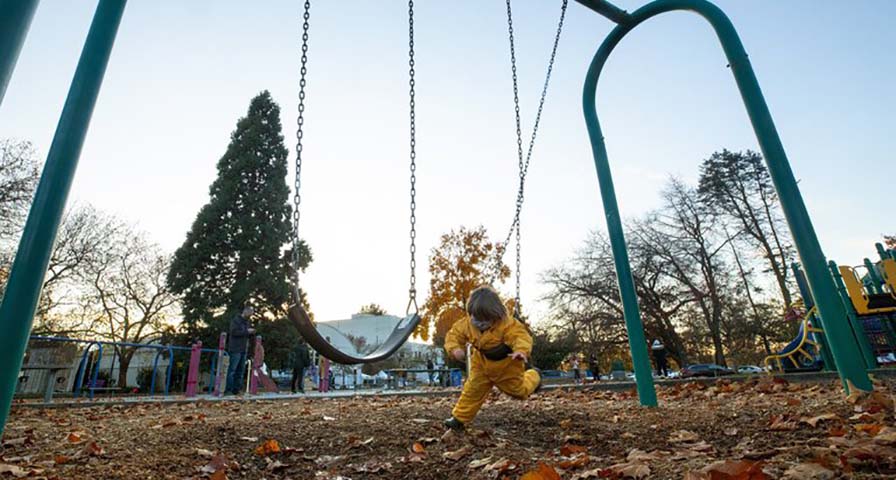Originally published Feb. 19, 2021 in The Seattle Times.
By Carla Santorno, Pooja S. Tandon and Bookie Gates
With most children going to school in front of computers without typical recess breaks, physical education and youth sports programs, our region’s youth face another health crisis — one of physical inactivity.
Fewer than one-quarter of school-age kids got the recommended 60 minutes of physical activity per day before COVID-19. Recent research shows inactivity among children has worsened further during this pandemic.
 We must reverse this troubling trend using collaboration and collective action to prioritize and reinvest in our communities’ commitment to youth physical activity. As a conduit for good physical and mental health and well-being, physical activity and play are even more critical now. The benefits of physical activity for youth are well-studied and can help mitigate the harmful effects of this pandemic during which children have been increasingly isolated, stressed and sedentary. Physical activity can also enhance children’s readiness to learn, improve attention, and protect against illness and infection.
We must reverse this troubling trend using collaboration and collective action to prioritize and reinvest in our communities’ commitment to youth physical activity. As a conduit for good physical and mental health and well-being, physical activity and play are even more critical now. The benefits of physical activity for youth are well-studied and can help mitigate the harmful effects of this pandemic during which children have been increasingly isolated, stressed and sedentary. Physical activity can also enhance children’s readiness to learn, improve attention, and protect against illness and infection.
During the past 20 years, while youth sports have become a $19 billion industry serving primarily white and wealthy children, physical education, recess, unstructured free play and community-based recreation have languished. Not surprisingly, rates of youth physical activity have declined, and the gap between those with access to physical activity and those without has widened. This crisis of inequitable access to physical activity is emblematic of disparities in health and educational outcomes that will follow children into adulthood.
We also know that parents are now more overwhelmed, especially in families of color and those in low-income neighborhoods for whom preexisting systemic inequities have been magnified by the pandemic. Black and brown children have comprised the vast majority of COVID-19 deaths (78% according to a recent CDC report) in the U.S. for those under 21 years of age. Furthermore, children living in lower income communities have less access to safe parks and green space, adding to the barriers that families face in engaging in physical activity during the pandemic.
We believe it is time for all of us — schools, municipalities, parks and recreation departments, health systems and community-based organizations — to reflect on how our policies and practices contribute to inequities of access. We need to work together to revise and create policies and programs that create meaningful change that centers youth furthest from play equity.
Collective investment in youth physical activity necessitates cross-sector collaboration. In our region, several promising initiatives point to a way forward for an investment in this notion of play equity. Tacoma Metro Parks and the Tacoma Public Schools forged a partnership that increased participation in rec-level youth sports 450% by revising their shared use agreements. The district also partnered with The Trust for Public Land on a new “Green Schoolyards” program to renovate and open access to school district properties as public parks, which will provide close-to-home park access to more than 40,000 Tacoma residents. The King County Play Equity Coalition, a collection of more than 100 organizations — from the Seattle Sounders to Seattle Children’s Hospital to Baseball Beyond Borders — formed in 2019 to break down systemic barriers that exclude low-income and youth of color from accessing play and sport.
Despite the potential of these efforts, increased commitment to equity is needed because the gaps these initiatives sought to close have been widened due to the pandemic. We need statewide youth physical activity legislative agendas to be championed by families, youth-serving organizations, funders and policymakers. We need schools to prioritize robust physical education programs that can take place at home or at school, adequate recess and unstructured breaks for students, and partnerships including shared use agreements with community-based organizations that allow them to operate sports and outdoor recreation programs on school grounds. We need bold transformation and a lasting commitment so all kids in our region have the opportunity to play, enjoy the outdoors and have a strong healthy start in life. Together we can reclaim play as a childhood right.
The path forward is through shared responsibility and collaboration. Our children’s health — and therefore our communities’ future well-being — is on the line.
Carla Santorno is superintendent of Tacoma Public Schools.
Pooja S. Tandon is a pediatrician, researcher at Seattle Children’s Hospital and associate professor at the University of Washington.
Bookie Gates is chair of the King County Play Equity Coalition.
Learn How the IHT Spirit System Supports Physical Education in Schools:




